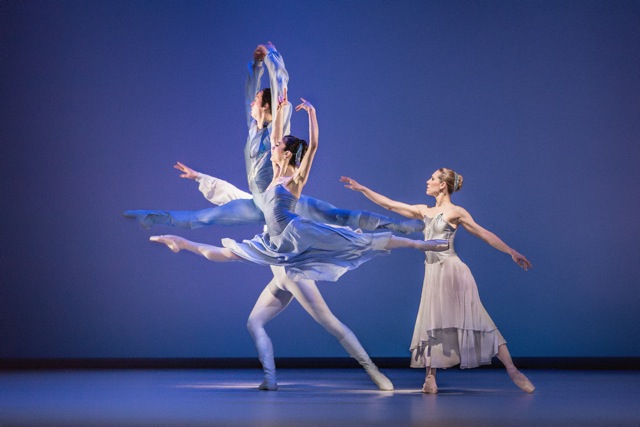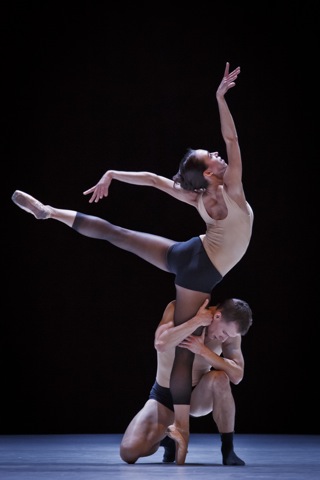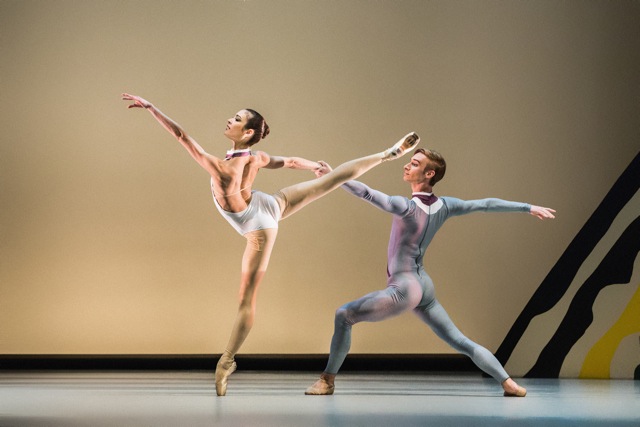 The ballet triple bill entitled Ballettissimo is another premiere of the 2014/2015 National Theatre season and it is performed on the State Opera stage. “I invented the title as an expression of something extreme in the sense of music terminology, such as pianissimo or fortissimo. In the world of music these words stand for certain extremes and I found it appropriate to use such a name for this new multiple-bill evening performance. It will replace the piece Americana III in our repertoire, that similarly consisted of older neo-classical and contemporary dance styles”, says the Director of the company and choreographer Petr Zuska. So the new premiere is based on a similar model. It makes use of the interpretation skills of the soloists as well we of the corps de ballet. The company has a chance to dance in challenging pieces. The evening opens with Mahler’s 1st Symphony in D Major (part of the 1st movement, 2nd and 3rd movement) and an amazing cast – Nikola Márová, Michal Štípa, Michaela Wenzelová and Jiří Kodym. Petr Zuska created this choreography as an homage to neoclassical style in 2010. It has not been performed much in Prague as the piece was intended for the World Exposition in China – EXPO in Shanghai. It is a piece with purely abstract, structured “white” choreographic composition. The dancers perform the individual variations, duets and shorter passages that are composed in the left-right direction, resembling the pace of time or, on the contrary, a latent stream going against time… and maybe also against the stave of the renowned musical score.
The profile conception is a much-favoured and useful tool for intensifying the stage suspension because the regard of dancers is directed to the unknown and the audience do not always see the expression in their faces. So they do not know where exactly the dances are heading to and that is beautiful. But at the same time, the given directions - full of repetitive arabesques piquées – unchanged throughout the entire marvellous music score render imposs
The ballet triple bill entitled Ballettissimo is another premiere of the 2014/2015 National Theatre season and it is performed on the State Opera stage. “I invented the title as an expression of something extreme in the sense of music terminology, such as pianissimo or fortissimo. In the world of music these words stand for certain extremes and I found it appropriate to use such a name for this new multiple-bill evening performance. It will replace the piece Americana III in our repertoire, that similarly consisted of older neo-classical and contemporary dance styles”, says the Director of the company and choreographer Petr Zuska. So the new premiere is based on a similar model. It makes use of the interpretation skills of the soloists as well we of the corps de ballet. The company has a chance to dance in challenging pieces. The evening opens with Mahler’s 1st Symphony in D Major (part of the 1st movement, 2nd and 3rd movement) and an amazing cast – Nikola Márová, Michal Štípa, Michaela Wenzelová and Jiří Kodym. Petr Zuska created this choreography as an homage to neoclassical style in 2010. It has not been performed much in Prague as the piece was intended for the World Exposition in China – EXPO in Shanghai. It is a piece with purely abstract, structured “white” choreographic composition. The dancers perform the individual variations, duets and shorter passages that are composed in the left-right direction, resembling the pace of time or, on the contrary, a latent stream going against time… and maybe also against the stave of the renowned musical score.
The profile conception is a much-favoured and useful tool for intensifying the stage suspension because the regard of dancers is directed to the unknown and the audience do not always see the expression in their faces. So they do not know where exactly the dances are heading to and that is beautiful. But at the same time, the given directions - full of repetitive arabesques piquées – unchanged throughout the entire marvellous music score render impossible any deeper emotional message. That is rather unfortunate because the well-known Mahler’s musical theme in each of the symphonic movements used in the ballet is inspired by folk music motifs, masterfully developed, and the choreography is not able to fulfil it in a more dynamic, physical and joyful way. Still it brings some piece and quite at the beginning, an atmosphere that is swept away by the following piece.
Choreographic reflection on our bodies’ thoughts
Jacopo Godani has become the guest choreographer with the National Theatre ballet company for the first time. For long, he has been a collaborator of the American choreographer William Forsythe. He was one of Forsythe’s dancers in the Frankfurt Ballet and later in the Forsyth Dance Company, which has been based in Dresden for many years and still tours to perform on the world’s most prestigious stages. The next season, Godani is going to take over the ensemble of prominent “Forsythe” dancers and will assume the head position in both cities, Dresden and Frankfurt upon Mohan. The title of Godani’s brand new opus,
Reflections on the Fate of Human Forms, does not serve as a key for deeper understanding of the piece. It is more about searching for new meanings of movement, stirring and blurring the established principles of classical dance, its technique and aesthetic criteria. The choreographer is constantly seeking the form on the human body, in the full physically demanding process and with all the human factors. And it works very well. In solos, duets, trios, quartets and pas de deux, in all parts of the logically structured sequence of scenes, he sees the human body as an endless shore hit by stormy thoughts.
He chose very lively and intelligent dancers and together they were searching for a disrupted soul in an aching body or unfulfilled relationships. In the dance passages and sequences, bodies seem like boneless and made of rubber. Rubber-like plasticity of pelvis movements, body axes, positions and pirouettes merge into infinity.
 Godani, a singular choreographer, is not innovative because he builds on Forsythe’s original movement language and spent a long time in his team, too! What is special is the way he works with his dancers.
The visual world resembles the one of Forsythe’s: almost naked bodies, in leotards (non-balletic here). The girls wear black panties and see-through black leotards, men have tight trousers. The girls dance on points. So the sharp, stabbing, breaking character of the movements gets a full poignancy.
The individual situations take place in sharply-shaped spaces, limited by light boundaries. The light is white and it determines the space on the black empty stage, deliberately sterile like a lab. The music accompaniment was composed by 48nord – Ulrich Müler and Siegfroed Rössert. The duo of German musicians was strongly inspired by the dance movements, so the music underlines the absurdity, urgency and insistency of the whole piece. Both musicians play acoustic instruments and make experimental music.
Godani, a singular choreographer, is not innovative because he builds on Forsythe’s original movement language and spent a long time in his team, too! What is special is the way he works with his dancers.
The visual world resembles the one of Forsythe’s: almost naked bodies, in leotards (non-balletic here). The girls wear black panties and see-through black leotards, men have tight trousers. The girls dance on points. So the sharp, stabbing, breaking character of the movements gets a full poignancy.
The individual situations take place in sharply-shaped spaces, limited by light boundaries. The light is white and it determines the space on the black empty stage, deliberately sterile like a lab. The music accompaniment was composed by 48nord – Ulrich Müler and Siegfroed Rössert. The duo of German musicians was strongly inspired by the dance movements, so the music underlines the absurdity, urgency and insistency of the whole piece. Both musicians play acoustic instruments and make experimental music.
The selected dancers perform very well, especially Kristina Němečková, Ondřej Vinklát, Viktor Konvalinka, but also Tereza Kučerová, Lenka Hrabovská, Mária Dorková, Mathias Deneux, Petr Strnad – all of them gave terriifying performances. The second cast will get its chance later this season.
 “Classical” dance incredibly vibrant and breath-taking
The third part of the evening was astonishingly captivating. Beethoven’s beautiful 7th Symphony in A Major conducted by the guest artist Jakub Klecker and performed by the State Opera orchestra. The choreography was created by Uwe Scholze. Unfortunately, this great choreographer has already deceased, and though he left behind many ballet pieces, he worked in the shade of other famous names of the Eur
“Classical” dance incredibly vibrant and breath-taking
The third part of the evening was astonishingly captivating. Beethoven’s beautiful 7th Symphony in A Major conducted by the guest artist Jakub Klecker and performed by the State Opera orchestra. The choreography was created by Uwe Scholze. Unfortunately, this great choreographer has already deceased, and though he left behind many ballet pieces, he worked in the shade of other famous names of the European, namely German, dance scene. That is the reason why he is less known in our country and the National Theatre presents his choreography for the first time.
Tribute to classical music, incredible musicality, fantastic sense of composition and structuring, literally architectural composition of dance in the name of music and space are obvious in most of his works. But here, with Beethoven’s 7
th Symphony, dance becomes music, explosion of joy and beauty. Scholze managed to transform the classical ballet technique, according to the German dance critic Horst Koegler, into a
“bridge between the past and present”. Like Cranko’s or Balanchine’s, Scholze’s “classical” dance is incredibly vibrant, joyful and dynamic. It is not a boring image. It rushes in full speed like a fast train. The dance passages and variations, challenging knots of partner dances requiring hard work of the male dancers in particular, are exquisitely choreographed. A whirlwind of lifted figures is like swishing and sliding with the bodies in the energy-charged space. They are switching quickly like the motifs in the music score. The geometrical and energetic attempt at seizing the space rises and grows from simple structures towards rich multi-layered composition. It is a great model for choreographic thinking. This piece of Scholz’s should be seen by all young choreographers – it can teach them how to develop a broad theme, a sort of “dancing house” from a simple e
lement or motif. The performances of the soloists and the corps de ballet, namely Nikola Márová with Michal Štípa, Aya Watanabe with Karel Audy, Mathias Deneux, Francesco Scarpato, Ondřej Vinklát and Gianvito Attimonelli, were exquisite. Andrea Kramešová coupled with Giovanni Rotola, and in second dance couples Sophie Benoito, Alina Nanu, Marta Drastíková, Matěj Šust, Kryštof Šimek, Dmytro Tenytsky and others danced beautifully, too.
Written from premieres on 5 and 6 March 2015, the State Opera Prague.
Ballettissimo
1st Symphony in D Major
Choreography and direction: Petr Zuska
Music: Gustav Mahler
Conductor: Jakub Klecker and Václav Zahradník
Costumes: Roman Šolc
Reflections on the Fate of Human Forms
Music: 48nord (Ulrich Müller and Siegfried Rössert)
Choreography, sets and costumes: Jacopo Godani
7th Symphony in A Major
Choreography, sets and cotumes: Uwe Scholz
Music: Ludwig van Beethoven
Conductor: Jakub Klecker and Václav Zahradník
Translation: Tereza Cigánková
 Godani, a singular choreographer, is not innovative because he builds on Forsythe’s original movement language and spent a long time in his team, too! What is special is the way he works with his dancers.
The visual world resembles the one of Forsythe’s: almost naked bodies, in leotards (non-balletic here). The girls wear black panties and see-through black leotards, men have tight trousers. The girls dance on points. So the sharp, stabbing, breaking character of the movements gets a full poignancy.
The individual situations take place in sharply-shaped spaces, limited by light boundaries. The light is white and it determines the space on the black empty stage, deliberately sterile like a lab. The music accompaniment was composed by 48nord – Ulrich Müler and Siegfroed Rössert. The duo of German musicians was strongly inspired by the dance movements, so the music underlines the absurdity, urgency and insistency of the whole piece. Both musicians play acoustic instruments and make experimental music.
Godani, a singular choreographer, is not innovative because he builds on Forsythe’s original movement language and spent a long time in his team, too! What is special is the way he works with his dancers.
The visual world resembles the one of Forsythe’s: almost naked bodies, in leotards (non-balletic here). The girls wear black panties and see-through black leotards, men have tight trousers. The girls dance on points. So the sharp, stabbing, breaking character of the movements gets a full poignancy.
The individual situations take place in sharply-shaped spaces, limited by light boundaries. The light is white and it determines the space on the black empty stage, deliberately sterile like a lab. The music accompaniment was composed by 48nord – Ulrich Müler and Siegfroed Rössert. The duo of German musicians was strongly inspired by the dance movements, so the music underlines the absurdity, urgency and insistency of the whole piece. Both musicians play acoustic instruments and make experimental music.

